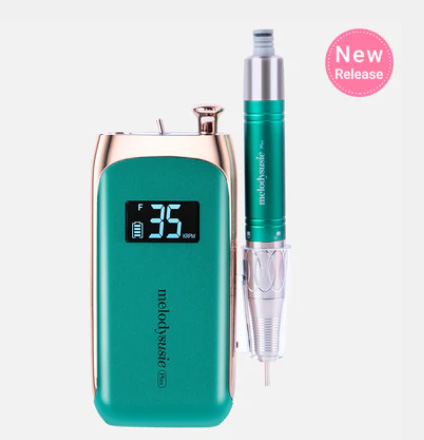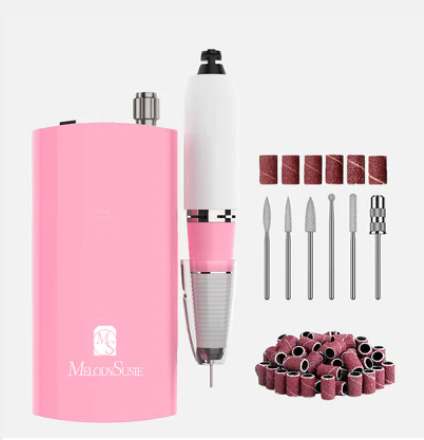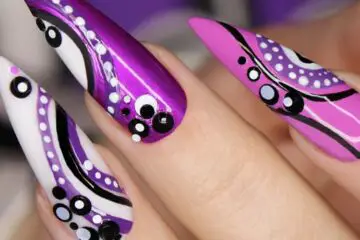What’s a nail drill? It’s the tool that manicurists use to reshape and smooth out nails, creating beautiful shapes and designs while also taking care of your health. It looks scary, but it’s actually pretty straightforward to operate. So let me tell you everything you need to know about using a nail drill in the perfect mani or pedi experience!
Unlock the Secrets of Nail Drill Magic: How Does It Work?
A nail drill is essentially an electric file that rotates at high speeds – up to 35,000 RPMs! This allows us manicurists to quickly and precisely grind down the surface layers of your nails. We can completely remove any thickened areas or ‘ridges’ from the nail plate itself, and create beautiful designs of any width or length, while still maintaining the integrity of the nail’s protective layers.

Different Bits:
There are a variety of different drill bits that can be used for different tasks, depending on how much shaping needs to be done. For example, there are diamond-tipped bits that are used for removing tough calluses and cuticles; carbide bits for filing and smoothing surface layers; cone-shaped bits for removing excess product from acrylic nails; and fine grit sanding bitss which are ideal for buffing nails to shine.
What to Expect When Using One:
Using a nail drill is surprisingly relaxing! You’ll feel a slight vibration in your hand, but nothing too uncomfortable. The sound of the drill can be quite loud at first – almost like a buzzing bee! – but you’ll get used to it pretty quickly. A good manicurist will also talk with you throughout the treatment, making sure you’re comfortable and happy with how things are going!
Tips For Getting the Best Results:
When asking for a manicure, make sure to ask for a drill service. This ensures that your nails will be filed and shaped perfectly, leaving them smooth and even. Secondly, don’t forget to take care of your skin afterwards! After using the nail drill, moisturize hands and feet with an oil or lotion to keep them soft and nourished.
How To Choose The Right Nail Drill For You:
When shopping for a nail drill, it’s important to make sure you
get one that’s reliable and powerful enough to do the job. Look for a model with adjustable speed settings, so you can customize it to your particular needs. Also pay attention to the type of bits included – some come with more than others!
Maintenance Tips:
Your nail drill will last longer if you take good care of it. Make sure to clean and disinfect it after each use, as well as oiling the motor occasionally. Always store in a dry place away from moisture and dust, and don’t forget to replace any worn out drill bits as soon as possible.
Using a Nail Drill for DIY Manicures and Pedicures:
DIY manicures and pedicures are becoming increasingly popular, and using a nail drill can help make them even more enjoyable. Whether you’re shaping your natural nails or creating custom acrylic designs, this tool is essential! Here’s how to use it on yourself at home:
Step One: Prep the Area
Before starting your DIY mani/pedi, be sure to prep the area. First, clip any excess nail length and push back cuticles. This will help to ensure that the drill bits are able to do their job properly.
Step Two: Select the Right Bit
Selecting the right drill bit is essential for getting the best results from your manicure or pedicure. Make sure to choose one that is suitable for the type of nail you are working on and the job at hand.
Step Three: Begin Drilling
Once you’ve selected the correct bit, it’s time to start drilling! Gently press down on the nail with your free hand, keeping it steady and still as you move the drill in a circular motion. Go slowly at first, gradually increasing pressure and speed as needed.
Step Four: Finishing Touches
Once you have achieved the desired shape or design, it’s time to finish up! Gently buff and file any stray edges with a nail file before applying your favorite topcoat. You’re now ready to show off your beautiful DIY mani/pedi!
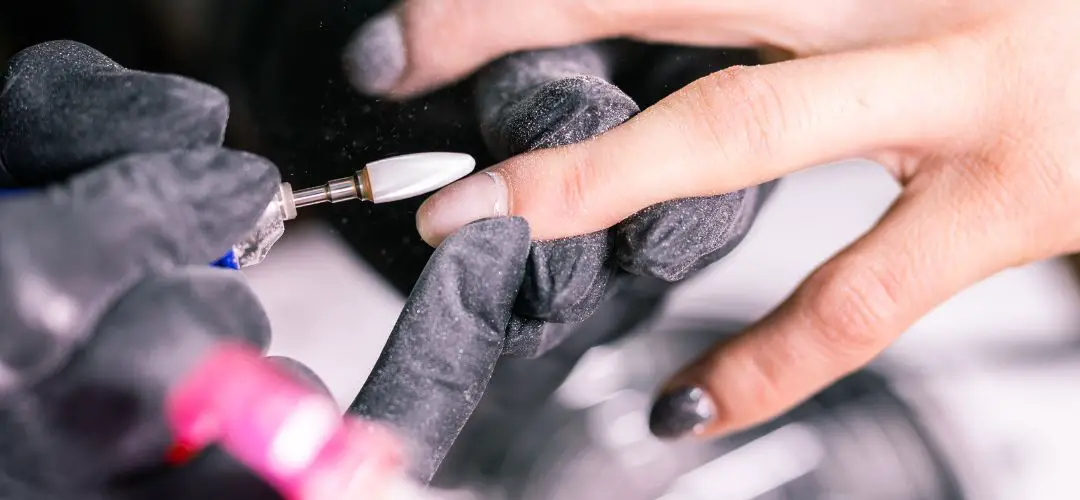
Safety Tips:
As with any tool, it’s important to always use your nail drill safely and responsibly. Be sure to wear protective eyewear at all times when operating the device and take regular breaks if needed.
When it comes to having perfectly groomed nails, there are a few secrets expert manicurists know that the rest of us don’t. Here’s what you need to know if you want salon-quality results at home.
Cleanliness is Key: One of the main things that any professional manicurist will do before starting work on a client’s nails is make sure their hands and feet are clean. This includes scrubbing away any dirt or oil from the cuticles and around the nails with soap and water. It also means sanitizing all tools and surfaces with an antiseptic solution.
Invest in Quality Tools: To get great results, it’s important to have the right tools. Investing in a good quality nail drill, cuticle nippers, and other essential items will make all the difference when it comes to manicures and pedicures.
Prepare Your Nails Beforehand: Preparing nails before starting is key for achieving smooth results. If you’re doing a mani or pedi on your own, use a nail file to remove any ridges or bumps from the nail plate before proceeding. This will help to ensure that the polish goes on evenly and looks neat.
Take Your Time: Manicures and pedicures can take time, so be prepared to put in the effort. Taking your time when doing nails ensures that you get a salon-quality finish without having to rush things.
Follow Up with Maintenance: Finally, to keep your nails looking flawless for longer, it’s important to follow up with maintenance. This includes regular filing and buffing, as well as using cuticle oil to keep the skin around your nails hydrated. With these tips in mind, you’ll be able to achieve salon-quality results every time!
Lastly, always make sure to safely store your nail drill when not in use – keep it stashed away in a dry place away from moisture and dust, and don’t forget to replace any worn out drill bits as soon as possible. With these tips in hand, you’re ready to create beautiful manicures and pedicures at home!
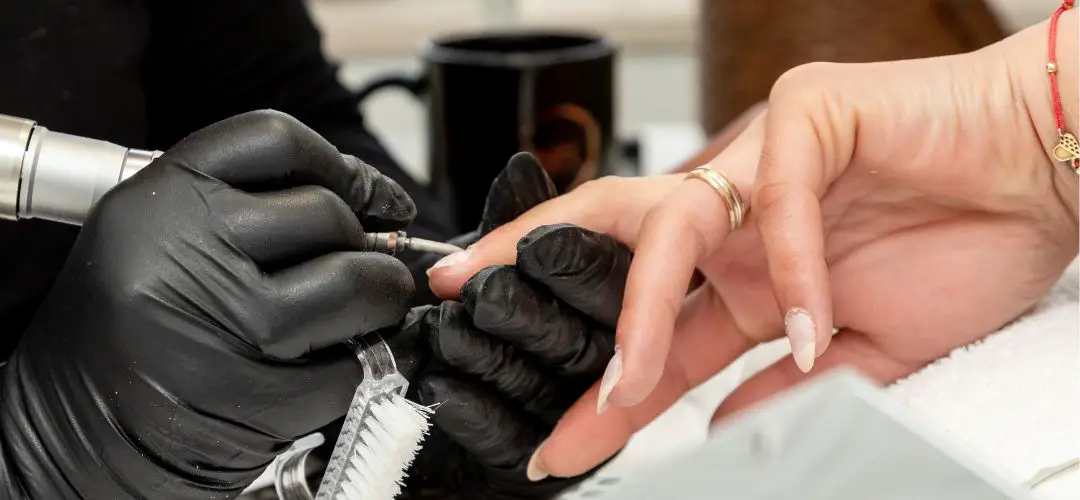
All You Need to Know About Nail Drills
Should you cut toenails wet or dry?
To get the best manicure or pedicure results, you should always cut your nails when they are dry. This will help to ensure that the edges are smooth and won’t snag or catch on clothing.
To ensure your drill bits always stay in optimal condition, use a sharpening stone or diamond abrasive wheel for regular maintenance. These tools help keep the bit edges sharp and smooth for precise drilling and filing action.
Why do nail techs drill your nail?
Nail technicians use drills to file and shape nails quickly and accurately. The drill is used in certain areas of the nail, such as around the cuticles and sidewalls, where regular filing can be difficult.
What type of bits are best for nail drills?
The type of bit that you should use will depend on what kind of look you’re trying to achieve. Different bits come in different shapes and sizes which can be used for various purposes such as filing, buffing, polishing, shaping and more
Is there an eco friendly way to do nails?
Yes! It is possible to go eco-friendly when it comes to manicures and pedicures. Look for products that are free from harsh chemicals, use natural ingredients, and vegan. Additionally, look for companies that offer refillable nail polishes instead of those in single-use packages. Finally, avoid using disposables like cotton rounds, wipers and nails wipes whenever you can. Instead opt for reusable microfiber cloths which can be cleaned and reused multiple times. With a few simple steps, your nails will look great without compromising on sustainability!
Are all nail drills the same?
No, not all nail drills are the same. Different models have different features and can be used for a variety of purposes. Some drills are designed specifically pedicures, while others come with multiple setting options to provide maximum control over speed and torque. It’s important to research the different types of drills available so you can find one that meets your specific needs.
Do nails need to breathe?
No, nails don’t need to breathe. In fact, you should try to keep your nails covered and protected as much as possible. This will help them stay strong and healthy-looking for longer, so you enjoy a beautiful manicure or pedicure for weeks on end! By using a nail drill correctly and following up with regular maintenance, you’ll be able to enjoy salon-quality results from the comfort of home.
What is the best way to hold the nail drill?
The best way to hold the nail drill is with your dominant hand, in a comfortable position. Make sure that you keep your grip steady and your wrist relaxed throughout the entire process. It’s also important to make sure that you are using the correct attachment for whatever type of manicure or pedicure job you’re doing – this will help ensure accuracy. With the proper technique, nail drills can give you a flawless finish without having to rush things. So don’t be afraid to take it slow and get salon-quality results every time!
What kind of power source is required for a nail drill?
Nail drills typically require a reliable power source, such as an electric outlet or battery. Many newer models are cordless, allowing you to take your nail drill with you wherever you go. Additionally, some models come with multiple speed settings so that you can adjust the speed of the drill as needed. With a reliable power source and adjustable speed settings, your manicure and pedicure jobs will be easy to complete as quickly and accurately a possible.
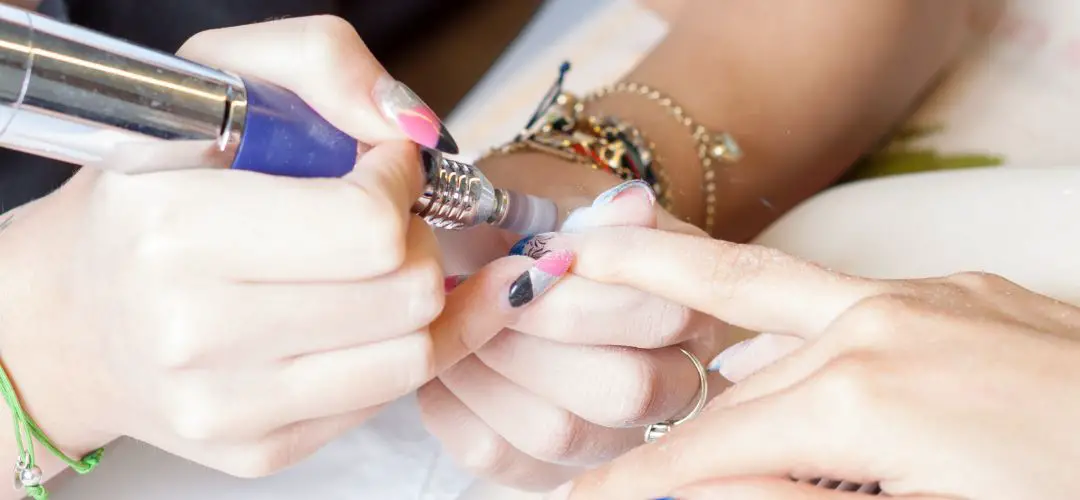
Can a nail drill be used on different surfaces?
Yes, a nail drill can be used on different surfaces. It can be used to file and shape the nails of your hands or feet, as well as to buff and polish acrylic nails or natural nails. Additionally, some models are designed to be used on gel nails or other synthetic materials. With the right attachments and settings, your nail drill will be able to handle any job you throw at it!
How do you select the right size drill bit?
The size of the drill bit depends on the type of job you are trying to do. Generally speaking, larger bits are used for filing and shaping nails, while smaller ones can be used for polishing and buffing. Additionally, each material you work with will generally require a different type of bit – so make sure that you read up on which ones are best suited for the task at hand.
Why do nail techs drill under nails?
Nail techs drill under nails for a variety of reasons. Generally speaking, it helps to file and shape the nail beds which can help create a more uniform look overall.

What are the other manicurist secrets?
Manicurists have a wealth of knowledge when it comes to making nails look their best. This can range from using the right products and techniques to selecting the perfect shade of polish. Additionally, having the right tools and accessories on hand is essential for any successful manicure or pedicure session – which includes things like nail files, clippers, buffers and specialized attachments for the drill. Finally, one key piece of advice that all manicurists follow is to always remember to use a clean tool when working on someone else’s nails.
What is the best nail shape to prevent chipping?
When it comes to preventing chipping on your nails, the most important factor is choosing a shape that fits your lifestyle. A longer, more squared-off shape, such as an almond or oval, tends to provide more protection from everyday wear and tear. However, if you prefer a rounder tip, like with a classic stiletto or French manicure shape, then taking extra steps to strengthen your nails will be necessary. Applying top coat every few days.
What is a Russian gel manicure?
A Russian Gel Manicure is a type of long-lasting nail treatment that works to strengthen your natural nails. This process involves filing, buffing, and polishing the nails as well as applying multiple layers of an adhesive gel polish. The final step is curing the nails under UV or LED light for several minutes to seal in the color and shine. When taken care of properly, this mani can last up to two weeks without chipping!
What is the difference between hand drill and electric drill?
The primary difference between a hand drill and an electric drill is power. A hand drill requires manual labor while an electric drill uses electricity to generate much more torque and speed. Electric drills are also much more versatile than hand drills since they can be used on a variety of materials with different drill bits.
What grit is best for nail drill?
The best sanding bit to use when working with artificial nails will depend on what kind of material you’re using and how thick it is. Generally speaking though, a medium-grit bit should be used for filing hard acrylics and gels while a finer-grit bit is best for buffing away ridges or smoothing out natural nails.
Can you do dip powder without drill?
Yes, it is possible to do a dip powder manicure without an electric nail drill. You can use traditional nail files and buffers to file the surface of the nails as well as gently remove any ridges that may appear. This process will take much longer than with a drill though, so keep that in mind if you’re on a time crunch!
What should I look for in a good quality nail drill?
When looking for an electric nail drill, it’s important to consider the power (measured in watts), speed control (adjustable revolutions per minute), and the type of motor used (for instance, geared motors are better suited for professional salon use). It’s also beneficial to select a cordless model that will give you more freedom of movement while working on clients. Lastly, make sure it comes with a variety of drill bits suitable for filing and buffing different kinds of nails. By taking all these factors into account, you’ll be able to find the best nail drill for your needs!
What are the benefits of using a nail drill?
The main benefit of using an electric nail drill is that it can help you achieve smoother, professional-looking results with less effort. It also allows you to work faster and more accurately than with other methods, as well as reduce any strain on your hands or wrists since there’s no need for manual labor. Additionally, drills come with different attachments that allow you to perform various functions such as filing, buffing, and shaping. This makes them incredibly versatile tools for both personal and professional use!
What Direction Should I Buff My Nails?
When buffing your nails with an electric nail drill, it’s important to ensure that you use the correct technique. Start by using a coarse-grit bit to gently file away any ridges or imperfections on the nail surface. Once any sharp edges have been removed, switch to a finer-grit bit and start buffing in one direction only.
Do All Common Drills Turn Clockwise?
Most drills are designed to turn in both directions, either clockwise or counterclockwise. This allows the user to switch between forward and reverse settings depending on what type of job they need to do. For example, if you need to buff a nail, it’s best practice to use the clockwise setting as this will provide more control over the drill bit. On the other hand, if you’re using your drill for filing purposes, a counterclockwise rotation may be more effective in removing excess material from the nails.
What Are The Advantages Of Using An Electric Nail Drill?
An electric nail drill offers numerous benefits when compared to other methods of nail care – namely speed, precision and convenience. Firstly, these drills allow you to work much faster than traditional methods, allowing you to save time and money. Secondly, they provide greater accuracy when filing or buffing nails, ensuring that you achieve smoother results with less effort. Lastly, electric nail drills are cordless, making them easily portable and convenient to use wherever you need them.
What Is The Difference Between Efile And Nail Drill?
An efile is a type of electric nail file which looks similar to a drill but has some key differences. While both tools are capable of filing and buffing the nails, an efile typically uses rotating metal points rather than spinning drill bits for these tasks. This makes it a more precise tool than the average drill – perfect for achieving clean lines and intricate shapes on the nails with ease.
Does Drill RPM Matter?
Yes, drill RPM (or revolutions per minute) is an important factor to consider when using a nail drill. Different types of jobs may require different speeds – for example, you’ll need to use a slow speed when filing or buffing the nails and a higher speed when drilling holes or trimming excess material. Generally speaking, it’s best practice to start on the lowest setting and increase the speed as necessary depending on what job you’re doing.
What Are The 2 Speeds On A Drill For?
Most electric nail drills are equipped with two speeds: low and high. The low setting is typically used for filing and buffing while the high setting can be used for drilling holes or trimming away excess material.
Which Way Should Nail Drill Spin?
When using an electric nail drill, most people prefer a clockwise rotation as this provides more control when filing or buffing the nails. However, some drills are designed to spin in both directions which allows users to switch between forward and reverse settings depending on their needs.
What Are The Different Styles Of Drill?
There are several different types of electric nail drills available – each suited for different tasks. Rotary drills are typically used for cutting and shaping nails while orbital models offer greater speed and precision when filing and buffing. Pencil drills are lightweight and easy to maneuver, making them ideal for detailed work such as polishing. Finally, adjustable torque models can be used for a variety of jobs due to their variable speed settings and improved motor control.
What is an e-file for nails?
An e-file (also known as an electric nail file) is a power tool that helps you quickly and precisely shape, buff, and polish your nails. It’s perfect for creating intricate designs on your nails or simply getting them into the exact shape you want. E-files are fast becoming one of the most popular tools used in nail salons around the world! So if you’re looking for that perfect manicure or pedicure, an e-file could be just what you need.
Conclusion | Nail drill (all secrets)
Nail drills can be a great tool for achieving salon-quality manicures and pedicures from the comfort of your own home. It is important to remember to hold the nail drill with your dominant hand in a comfortable position and make sure that you are using the correct attachment for whatever type of manicure or pedicure job you’re doing, as this will help ensure accuracy.
Additionally, it is helpful to use a reliable power source, such as an electric outlet or battery, and choose a model with adjustable speed settings so that you can work at the pace best suited to each job. Nail drills can be used on different surfaces including nails of your hands or feet, acrylic nails, natural nails, gel nails, and other synthetic materials.
The size of the drill bit needed depends on the type of job you are trying to do, and it is important to read up on which ones are best suited for the task at hand Nail techs also drill nails in order to help file shape the nail beds, creating a more uniform look overall Manicurists follow a variety of tips and tricks to make sure that their clients’ nails always look their best including using the right products, techniques, colors, tools and accessories.
Finally, an essential piece of advice for any manicurist is to always use clean tools when working on someone else’s nails! With these tips and guidance, anyone can use a nail drill with confidence for all of their manicure and pedicure needs.
Nail art never looked so good
Thanks to your skilled hand and handy nail drill!
MeteorBeauty Team ❤️
